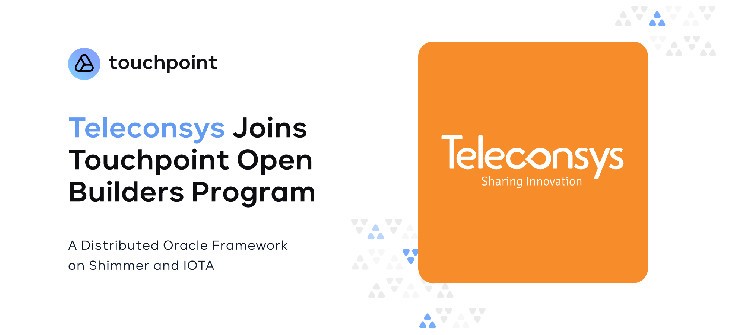Touchpoint Open Builders Program Welcomes Teleconsys

A Distributed Oracle Framework on Shimmer and IOTA
Teleconsys (www.teleconsys.it), a leading cybersecurity firm, has joined the Touchpoint Open Builders Program with their project, dOra. Built using the IOTA Identity Framework, dOra aims to redefine IoT infrastructure security by leveraging decentralized technologies and collective evaluation.
Recognizing the limitations of conventional approaches, Teleconsys developed dOra to empower authorized individuals to execute critical tasks autonomously, mitigating human error and enhancing protection against malicious attacks. Let’s learn more in Teleconsys’ own words.
Teleconsys introduces itself
“As cybersecurity experts who assist organizations in designing highly secure IT infrastructures, we have realized that traditional centralized platforms face significant vulnerabilities, including attacks, data leaks, and malfunctions at the application layer, which most cybersecurity tools fail to adequately address.
Consequently, the most viable cybersecurity solution is to restrict critical tasks to an autonomous, decentralized system on request by a committee of authorized individuals. With an authorized committee, it becomes virtually impossible for all members to collectively execute a wrong task.To find a solution, we developed a decentralized infrastructure for IoT, focusing on IOTA Identity for data authenticity. To ensure security, we designed a specialized device with the STM32 U5 microcontroller, featuring an embedded «trust zone» for secure execution. With this foundation, we aimed to decentralize data collection and device management in IoT solutions.
The result is dOra (“Distributed Oracle”). Similar to the IOTA Smart Contract Framework, dOra enables the creation of independent node committees that establish trust through collective evaluation. The committee acts as a programmable entity capable of collecting data from various sources, processing it using client-supplied Docker images, signing the data with distributed threshold signatures, publishing it to any destination, and storing it in separate object storages controlled by each committee member.
dOra has diverse applications, from creating a distributed supervisor for IoT infrastructure to building distributed storage accessible through the IOTA network, REST API, or the IPFS standard interface. Additionally, it can function as a traditional blockchain Oracle by capturing data, integrating it into the ledger, and triggering smart contracts.
An advantage of dOra is that each committee possesses its own identity based on the W3C DID, which includes a public key. Consequently, the committee can sign data and transactions by combining partial signatures from its members. However, individual members can’t perform this task independently, as there is no committee private key. Instead, each member signs their own produced data, and a valid committee signature can only be generated if the majority of members produce identical data.
To enable reliable communication among committee members and ensure data integrity, dOra utilizes IOTA. It facilitates Proof of Inclusion, certifying the existence of data at a specific date and time, as well as Proof of Conservation, which confirms that data is stored on multiple distinct object storages managed independently.
Using dOra, we’ve also created Cyronclad, a fully decentralized IoT infrastructure that resolves the common challenges faced by cloud-based infrastructures. Cyronclad can be used to create a new IoT network or to enhance existing setups. By employing a dOra-based committee of nodes to handle critical processes, Cyronclad eliminates any critical vulnerabilities in the infrastructure.

The dOra project is currently in the testing phase. Our ideal partners are innovative companies seeking support in designing and developing a critical platform or improving an existing one. Once we complete the initial proofs-of-concept and trials, our plan is to make Cyronclad accessible to the public, either as a service or as a dedicated tenant.
While our competitors primarily provide IoT solutions as service providers, Teleconsys distinguishes itself as a system integrator. As a result, we can collaborate with providers to handle critical tasks within standard solutions. While dOra, as a development framework, shares similarities with well-known solutions like Chainlink, our unique approach, utilizing IOTA Identity and granting data storage, sets dOra apart from any other distributed programmable systems.
Shimmer plays a pivotal role in our go-to-market strategy as it addresses the selection of committee members. By utilizing Shimmer, the platform owner can independently and possibly anonymously select committee participants. This approach assures platform users that even the platform owner cannot manipulate the committee into executing tasks incorrectly.”
Conclusion






 Bitcoin
Bitcoin  Ethereum
Ethereum  Tether
Tether  USDC
USDC  TRON
TRON  Dogecoin
Dogecoin  Cardano
Cardano  Bitcoin Cash
Bitcoin Cash  Chainlink
Chainlink  LEO Token
LEO Token  Monero
Monero  Stellar
Stellar  Zcash
Zcash  Litecoin
Litecoin  Hedera
Hedera  Dai
Dai  Cronos
Cronos  OKB
OKB  Tether Gold
Tether Gold  Ethereum Classic
Ethereum Classic  KuCoin
KuCoin  Gate
Gate  Algorand
Algorand  Cosmos Hub
Cosmos Hub  VeChain
VeChain  Dash
Dash  Tezos
Tezos  Stacks
Stacks  TrueUSD
TrueUSD  IOTA
IOTA  Basic Attention
Basic Attention  Theta Network
Theta Network  Decred
Decred  NEO
NEO  Qtum
Qtum  Synthetix
Synthetix  Ravencoin
Ravencoin  0x Protocol
0x Protocol  DigiByte
DigiByte  Zilliqa
Zilliqa  Nano
Nano  Numeraire
Numeraire  Siacoin
Siacoin  Waves
Waves  Ontology
Ontology  Status
Status  Enjin Coin
Enjin Coin  BUSD
BUSD  Pax Dollar
Pax Dollar  Hive
Hive  Lisk
Lisk  Steem
Steem  Huobi
Huobi  OMG Network
OMG Network  NEM
NEM  Bitcoin Gold
Bitcoin Gold  Augur
Augur  Ren
Ren